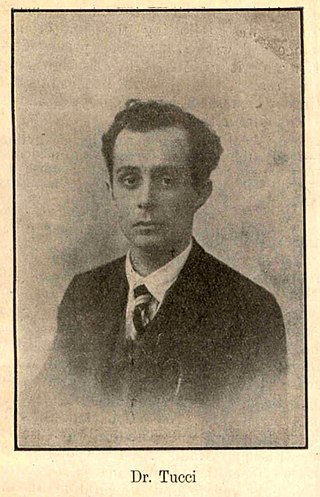Related Research Articles

Shaivism is one of the major Hindu traditions, which worships Shiva as the Supreme Being. One of the largest Hindu denominations, it incorporates many sub-traditions ranging from devotional dualistic theism such as Shaiva Siddhanta to yoga-orientated monistic non-theism such as Kashmiri Shaivism. It considers both the Vedas and the Agama texts as important sources of theology. According to a 2010 estimate by Johnson and Grim, Shaivism is the second-largest Hindu sect, constituting about 253 million or 26.6% of Hindus.

Giuseppe Tucci was an Italian orientalist, Indologist and scholar of East Asian studies, specializing in Tibetan culture and the history of Buddhism. During its zenith, Tucci was a supporter of Italian fascism, and he used idealized portrayals of Asian traditions to support Italian ideological campaigns. Tucci was fluent in several European languages, Sanskrit, Bengali, Pali, Prakrit, Chinese and Tibetan and he taught at the University of Rome La Sapienza until his death. He is considered one of the founders of the field of Buddhist Studies.

Abhinavagupta was a philosopher, mystic and aesthetician from Kashmir. He was also considered an influential musician, poet, dramatist, exegete, theologian, and logician – a polymathic personality who exercised strong influences on Indian culture.

Swami Lakshman Joo, born Lakshman Raina and also called Lal Sahib by his followers, was a mystic and scholar of Kashmir Shaivism.

The Kashmir Shaivism tradition, also called Trika Shaivism, is a non-dualist branch of Shaiva-Shakta Tantra Hinduism that originated in Kashmir after 850 CE. In its place of origin in Kashmir, this tradition is commonly referred to as "Kashmiri Shaivism." It later spread beyond Kashmir, with its great scholar Abhinavagupta calling it "Trika". It particularly flourished in the states of Odisha and Maharashtra. Defining features of the Trika tradition are its idealistic and monistic Pratyabhijna ("Recognition") philosophical system, propounded by Utpaladeva and Abhinavagupta, and the centrality of the three goddesses Parā, Parāparā, and Aparā.

The Tibetan Buddhist canon is a loosely defined collection of sacred texts recognized by various schools of Tibetan Buddhism, comprising the Kangyur or Kanjur and the Tengyur or Tanjur.

The Tengyur or Tanjur or Bstan-’gyur is the Tibetan collection of commentaries to the Buddhist teachings, or "Translated Treatises".
Tantrāloka is a treatise of Abhinavagupta, a writer and philosopher of the Kashmir Shaivism school of Hindu philosophy.

Buddhist logico-epistemology is a term used in Western scholarship to describe Buddhist systems of pramāṇa and hetu-vidya. While the term may refer to various Buddhist systems and views on reasoning and epistemology, it is most often used to refer to the work of the "Epistemological school", i.e. the school of Dignaga and Dharmakirti which developed from the 5th through 7th centuries and remained the main system of Buddhist reasoning until the decline of Buddhism in India.
Prakāśa is a concept in Indian philosophy translated by various authors as "light", "luminosity", "shining forth", "manifestation", "splendour", "light of consciousness" and so forth.
Indonesian Esoteric Buddhism or Esoteric Buddhism in Maritime Southeast Asia refers to the traditions of Esoteric Buddhism found in Maritime Southeast Asia which emerged in the 7th century along the maritime trade routes and port cities of the Indonesian islands of Java and Sumatra as well as in Malaysia. These esoteric forms were spread by pilgrims and Tantric masters who received royal patronage from royal dynasties like the Sailendras and the Srivijaya. This tradition was also linked by the maritime trade routes with Indian Vajrayana, Tantric Buddhism in Sinhala, Cham and Khmer lands and in China and Japan, to the extent that it is hard to separate them completely and it is better to speak of a complex of "Esoteric Buddhism of Mediaeval Maritime Asia." Many key Indian port cities saw the growth of Esoteric Buddhism, a tradition which coexisted alongside Shaivism.
The Sarvatathāgatatattvasaṃgraha sutra, also known as the Tattvasaṃgraha Tantra, is an important seventh century Indian Buddhist tantric text. Although the scripture refers itself as a Mahayana sutra, the content is mainly tantric in nature and thus is sometimes called a tantra. This work is an important source for the Shingon tradition.
The Istituto Italiano per l'Africa e l'Oriente (IsIAO), known in English as the Italian Institute for Africa and the Orient, was established in Rome in 1995, as the result of the merging of Italian Institute for the Middle and the Far East (IsMEO) with the Istituto Italo-Africano (IIA). It closed in 2012. Its museum collection is now overseen by the Polo Museale del Lazio.

David Llewellyn Snellgrove, FBA was a British Tibetologist noted for his pioneering work on Buddhism in Tibet as well as his many travelogues.
Indian art evolved with an emphasis on inducing special spiritual or philosophical states in the audience, or with representing them symbolically.

Bettina Sharada Bäumer is an Austrian-born Indian scholar of religion. Bäumer has been described by Vandana Parthasarathy, writing in The Hindu, as a "renowned Indologist, one of the foremost expounders of Kashmir Saivism and a well-known figure in the field of inter-religious dialogue". She was awarded the Austrian Decoration for Science and Art by Government of Austria in 2012 and Padma Shri by Government of India in 2015 for her contribution to Literature and Education. She was awarded the Ulrich Winkler Award for Comparative Theology and Study of Religions in 2023.

Carlo Formichi was an Italian linguist, Anglicist and orientalist, English and Sanskrit Scholar. He took a keen interest in Buddhism and Hindu philosophy.
Giovanni Verardi is an Italian archaeologist specialising in the civilisations of central Asia and India. With extensive academic and fieldwork experience, he has published findings about sites in Afghanistan, Nepal, India, and China in particular. Verardi has joined or directed several long archaeological missions to central Asia, and held positions on numerous Italian scientific boards. He has a particular interest in Indian iconography and history.
Gherardo Gnoli was a historian of Italian religions and Iran expert.
Śaṅkaranandana, was a Mahayana Buddhist philosopher, and a brahmin lay devotee (upāsaka) active in Kashmir in the epistemological (pramana) tradition of Dignaga and Dharmakīrti. He was quite influential in both Kashmir and Tibet, and became known as "the second Dharmakīrti," and “the Great Brahmin.”